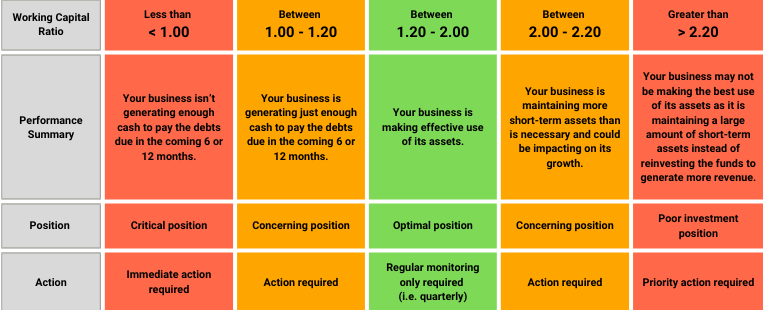Are you effectively managing the Working Capital in your business?
In challenging times, cash is one of the most critical success factors for you to focus on in your business which is best done through the understanding and effective management of your business’ Working Capital.
Working Capital is the money available to meet your current, short-term obligations. To ensure your Working Capital is working well for your business and the investment in Working Capital is at an appropriate level, you’ll need to calculate your current levels, project your future needs and consider ways to make sure you always have enough cash.
Working Capital Management, one of the key business value driver areas we identified in the second article of our “Working On The Business (OTB)” series (available here), focuses on ensuring that adequate cash flow (i.e. money available in the business) is always maintained to meet its short-term commitments (i.e. day-to-day operating expenses) while using its financial resources in the most productive and efficient way and also plays an important part in determining the long-term financial health of your business.
Working Capital Measures
We included some of the following examples of key Working Capital measures in our recent On The Business Scorecard blog (available here), where your business’ Working Capital level is calculated using the following financial position components reported on its balance sheet:
Working Capital = Current Assets – Current Liabilities
Current Assets (e.g., cash and bank funds, accounts receivable = debtors, inventory, work-in-progress, and prepayments)
Current Liabilities (e.g., bank overdraft, accounts payable = creditors, FBT, GST, Income Tax, accrued wages and interest owed, provisions)
The most common measure of Working Capital, which banks often require in their debt facility covenants, is:
Working Capital Ratio = Current Assets / Current Liabilities
Guideline for Working Capital Ratios
While it isn’t possible to specify the right Working Capital Ratio for your business, as this will differ depending on the industry you are operating in and the trading conditions in the current environment, the following table provides a high level “generalised” guideline you can use as a starting point to determine the right number for you.

If your business’ Working Capital ratio is less than 1.20, then you need as a high priority to focus in on each of the key components of your Current Assets as not all of these assets, in particular inventory and/or work-in-progress, can be turned into cash in the very short-term (i.e., within 1 – 3 months) to help the business meet its very short-term financial liabilities. To help you with this focus, exclude inventory and/or work-in-progress from the Current Assets and calculate what is known as the Quick or Acid-Test Ratio which the Banks also look at.
Run these calculations as at the end of your previous financial year (e.g. 31 March 2022), the quarters ended since then (e.g. 30 June 2022) and each month since the end of the previous quarter (e.g. 31 July 2022). This will provide you with a clear indication of whether your Working Capital position is strengthening or weakening.
Increasing Working Capital
The only way to increase your business’ Working Capital, for example to help cover project-related expenses or a temporary drop in sales, is to add to Current Assets and/or reduce Current Liabilities.
Options include:
- Improving the management and collection of your business’ accounts receivable or debtors’ balances
Calculation of the Debtors’ Collection Days (aka Days Sales Outstanding “DSO”) will help identify how efficient your debt collection process is:
Debtors’ Collection Days = $ Average Debtors / $ Total Credit Sales x number of days (for a given period e.g. 6 or 12 months)
As a rule, your business should operate with an average in the range of 30 – 45 days for customers to pay for services provided to them on but depending on your specific circumstances your ideal number could end up being much higher or lower than this range.
The APQC (American Productivity & Quality Center) Accounts Receivable Open Standards Benchmarking survey completed by 5,204 survey participants in various industries, as reported in CFO magazine in May 2018, identified on average that the fastest, top performing collectors get paid in 30 days or less on average, the bottom performers take 48 days or longer to collect on their invoices and at the median, companies need about 36 days to complete the debtors’ collections. - Analysing and optimising inventory management to reduce overstocking and the likelihood that inventory will need to be written off
Calculation of the Inventory Turnover Ratio will provide a good indication of how efficiently your business is managing inventory to meet demand but without tying up too much cash until it can be sold.
Inventory Turnover Ratio = $ Total Cost of Goods Sold / $ Average Inventory (for a given period e.g. 6 or 12 months)
If your business has an ongoing, material level of work-in-progress, then divide the Total Cost of Goods Sold $ by the combined Average Inventory and Work-in-Progress $ for a given period. - Analysing and reducing expenses which in turn reduces accounts payable or creditors balances
- Taking on long-term debt which increases current assets by adding to your business’ available cash but doesn’t overly increase current liabilities or refinancing short-term debt as longer-term debt.
Author: Kerry Ludlam, Management Response Limited
We can help you right-size your business' Working Capital
We have the know-how built up from over 30+ years working both In and On the Business with medium sized businesses and Not for Profit (NFP) organisations to help you identify the ‘what to focus on’ in right-sizing the Working Capital investment for your business to help you drive improvement and build value.


